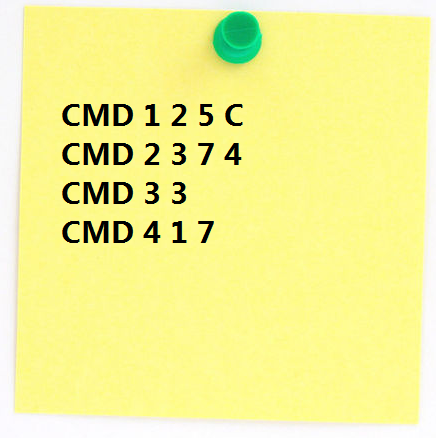Combination Lock
描述


Finally, you come to the interview room. You know that a Microsoft interviewer is in the room though the door is locked. There is a combination lock on the door. There are N rotators on the lock, each consists of 26 alphabetic characters, namely, 'A'-'Z'. You need to unlock the door to meet the interviewer inside. There is a note besides the lock, which shows the steps to unlock it.
Note: There are M steps totally; each step is one of the four kinds of operations shown below:
Type1: CMD 1 i j X: (i and j are integers, 1 <= i <= j <= N; X is a character, within 'A'-'Z')
This is a sequence operation: turn the ith to the jth rotators to character X (the left most rotator is defined as the 1st rotator)
For example: ABCDEFG => CMD 1 2 3 Z => AZZDEFG
Type2: CMD 2 i j K: (i, j, and K are all integers, 1 <= i <= j <= N)
This is a sequence operation: turn the ith to the jth rotators up K times ( if character A is turned up once, it is B; if Z is turned up once, it is A now. )
For example: ABCDEFG => CMD 2 2 3 1 => ACDDEFG
Type3: CMD 3 K: (K is an integer, 1 <= K <= N)
This is a concatenation operation: move the K leftmost rotators to the rightmost end.
For example: ABCDEFG => CMD 3 3 => DEFGABC
Type4: CMD 4 i j(i, j are integers, 1 <= i <= j <= N):
This is a recursive operation, which means:
If i > j: Do Nothing Else: CMD 4 i+1 j CMD 2 i j 1For example: ABCDEFG => CMD 4 2 3 => ACEDEFG
输入
1st line: 2 integers, N, M ( 1 <= N <= 50000, 1 <= M <= 50000 )
2nd line: a string of N characters, standing for the original status of the lock.
3rd ~ (3+M-1)th lines: each line contains a string, representing one step.
输出
One line of N characters, showing the final status of the lock.
提示
Come on! You need to do these operations as fast as possible.
- 样例输入
-
7 4 ABCDEFG CMD 1 2 5 C CMD 2 3 7 4 CMD 3 3 CMD 4 1 7
样例输出 -
HIMOFIN
1 import java.util.Scanner; 2 3 4 public class Main { 5 6 7 public static void main(String[] argv){ 8 9 Scanner in = new Scanner(System.in); 10 int M = in.nextInt(); 11 int N = in.nextInt(); 12 in.nextLine(); 13 String source = in.nextLine(); 14 String[] move= new String[N]; 15 for(int i=0; i<N;i++){ 16 move[i]=in.nextLine(); 17 } 18 in.close(); 19 int[] int_Source = new int[M]; 20 char[] c_Source = source.toCharArray(); 21 for(int i=0; i<M;i++){ 22 int_Source[i]= c_Source[i]-65; 23 } 24 for(int i=0; i<N;i++){ 25 String[] temp = move[i].split(" "); 26 switch(temp[1]){ 27 case "1": 28 if(temp[4].length()==1) 29 oneMethod(int_Source,Integer.parseInt(temp[2]),Integer.parseInt(temp[3]),((int)(temp[4].toCharArray()[0]))-65); 30 break; 31 case "2": 32 secondMethod(int_Source,Integer.parseInt(temp[2]),Integer.parseInt(temp[3]),Integer.parseInt(temp[4])); 33 break; 34 case "3": 35 thirdMethod(int_Source,Integer.parseInt(temp[2])); 36 break; 37 case "4": 38 fourthMethod(int_Source,Integer.parseInt(temp[2]),Integer.parseInt(temp[3])); 39 break; 40 } 41 /* 42 for(int out:int_Source ){ 43 System.out.println(out+" "); 44 } 45 System.out.println(); 46 */ 47 } 48 for(int out:int_Source ){ 49 System.out.print((char)(out+65)); 50 } 51 } 52 53 54 55 56 57 public static void oneMethod(int[] s, int i, int j,int k){ 58 59 for(int p=i-1; p<j; p++){ 60 s[p]=k; 61 s[p]=s[p]%26; 62 } 63 64 } 65 66 public static void secondMethod(int[] s, int i, int j,int k){ 67 68 for(int p=i-1; p<j; p++){ 69 s[p]=s[p]+k; 70 s[p]=s[p]%26; 71 } 72 } 73 74 public static void thirdMethod(int[] s, int i){ 75 int[] temp =new int[s.length]; 76 for(int q=0; q<s.length;q++){ 77 temp[q]=s[q]; 78 } 79 for(int p=0; p<s.length; p++){ 80 if(i+p<s.length) 81 s[p]=temp[i+p]; 82 else 83 s[p]=temp[(i+p)%s.length]; 84 s[p]=s[p]%26; 85 } 86 87 } 88 89 public static void fourthMethod(int[] s, int i, int j){ 90 91 for(int p=i-1;p<j;p++ ){ 92 s[p]=s[p]+p-i+2; 93 s[p]=s[p]%26; 94 } 95 } 96 97 }







 本文介绍了一道关于组合锁的算法题目,涉及四种类型的锁操作:字符设置、旋转操作、位移操作及递归操作,并提供了一个Java实现示例。
本文介绍了一道关于组合锁的算法题目,涉及四种类型的锁操作:字符设置、旋转操作、位移操作及递归操作,并提供了一个Java实现示例。

















 被折叠的 条评论
为什么被折叠?
被折叠的 条评论
为什么被折叠?








